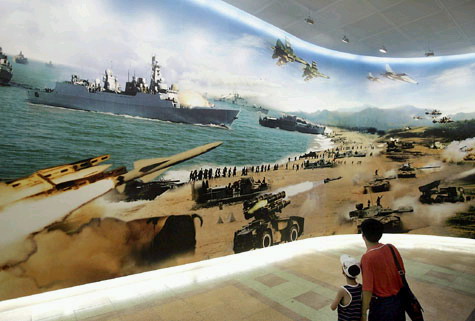Lin Biao regains his place in army history
(Xinhua)Updated: 2007-07-17 08:54
Marshal Lin Biao, who was handpicked by Chairman Mao Zedong to succeed him as China's leader but who died a traitor, has been resurrected as an army hero in a new exhibition in Beijing's Military Museum.
 Visitors view a huge poster showing military maneuvers at an exhibition that opened yesterday in Beijing to celebrate the 80th anniversary of the founding of the People's Liberation Army. [Xinhua]  |
Lin, denounced for his "treacherous" plot to overthrow Mao, is shown with his nine peers in a display rarely seen since his death in September 1971.
"With objective thinking, we decided to put the picture of Lin Biao along with the other nine marshals," said Jiang Tingyu, senior researcher at the Chinese Military Museum. "We have to show history as it was."
The 10 marshals have been praised since the founding of the People's Republic of China.
Lin died in a plane crash in Mongolia while fleeing after a coup attempt. He retained the rank of marshal, but his name and portrait have rarely appeared in public since.
Widely regarded as a talented military leader, Lin led the Communist forces in several notable victories in the wars against Japanese invaders in the 1930s and 1940s and the Kuomintang regime. He was a principal leader in two of the three biggest victories over the Kuomintang Army in the late 1940s.
In 1955, Lin was honored as a marshal.
However, he and Mao held different political views that developed into a rift. Lin approved a coup against Mao but fled after Mao learned of his intentions.
Lin's infamy remained even after Mao's death in 1976. The Supreme People's Court in 1981 determined that Lin was responsible for "counter-revolutionary" activities. He was identified as the "ringleader of the coup," but his name is mentioned twice in middle school textbooks.
The 1997 edition of the Chinese Military Encyclopedia also commented on both the official judgment against Lin as well as his military accomplishments.
"The public showing of Lin's picture shows that we respect history," said a visitor to the Beijing exhibition.
The exhibits include declassified materials including details on research into atomic weapons and satellites.
A manually operated mechanical computer, which was used in atomic weapons research and development, is on public display for the first time.
The free exhibition will run until August 20.
|
||
|
||
|
|